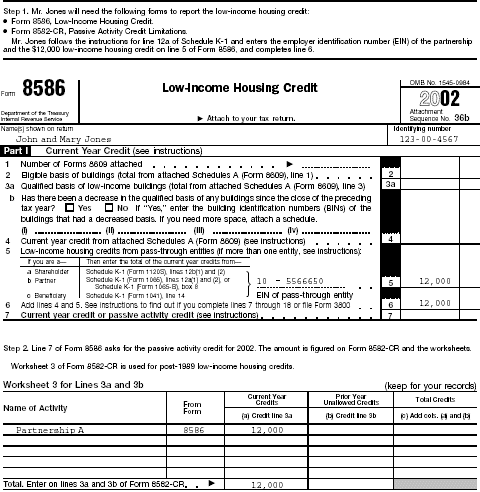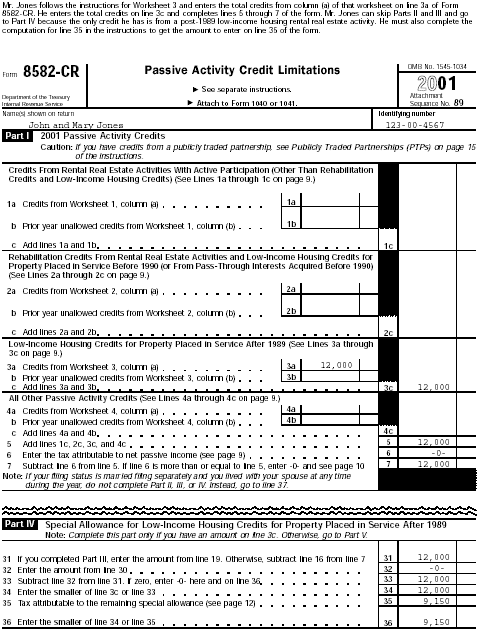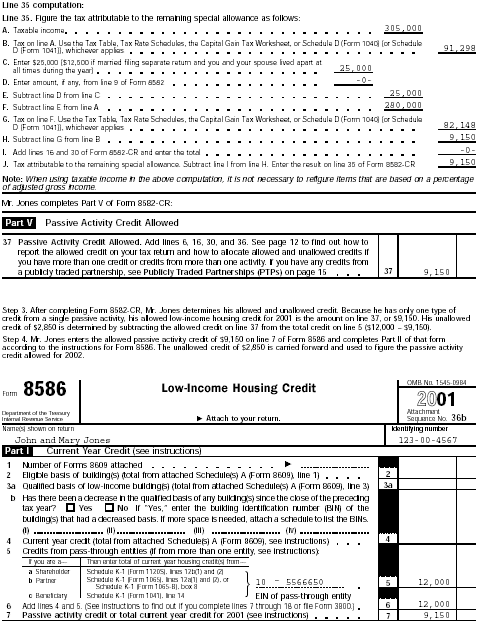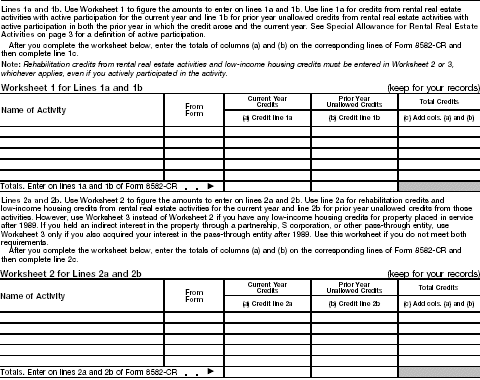Trade or Business Activities
A trade or business activity is an activity (other than a rental activity or an activity treated as incidental to an activity of holding property for investment) that:
- Involves the conduct of a trade or business (within the meaning of section 162),
- Is conducted in anticipation of starting a trade or business, or
- Involves research or experimental expenditures deductible under section 174 (or that would be if you chose to deduct rather than capitalize them).
Reporting Credits From the Activities
Trade or business activities with material participation. If you materially participated in a trade or business activity, the activity is not a passive activity. Report the credits from the activity on the forms you normally use.
Trade or business activities without material participation. If you did not materially participate in a trade or business activity, the activity is a passive activity. Generally, you must use Worksheet 4 on page 11 to figure the amount to enter on Form 8582-CR for each trade or business activity in which you did not materially participate. However, if you held the activity through a PTP, special rules apply. See Publicly Traded Partnerships (PTPs) on page 15.
Material Participation
For the material participation tests that follow, participation generally includes any work done in connection with an activity if you owned an interest in the activity at the time you did the work. The capacity in which you did the work does not matter. However, work is not participation if:
- It is not work that an owner would customarily do in the same type of activity and
- One of your main reasons for doing the work was to avoid the disallowance of losses or credits from the activity under the passive activity rules.
Proof of participation. You may prove your participation in an activity by any reasonable means. You do not have to maintain contemporaneous daily time reports, logs, or similar documents if you can establish your participation by other reasonable means. For this purpose, reasonable means include, but are not limited to, identifying services performed over a period of time and the approximate number of hours spent performing the services during that period, based on appointment books, calendars, or narrative summaries.
Test for investors. Work done as an investor in an activity is not treated as participation unless you were directly involved in the day-to-day management or operations of the activity. For purposes of this test, work done as an investor includes:
- Studying and reviewing financial statements or reports on operations of the activity.
- Preparing or compiling summaries or analyses of the finances or operations of the activity for your own use.
- Monitoring the finances or operations of the activity in a nonmanagerial capacity.
Test for a spouse. Participation by your spouse during the tax year in an activity you own may be counted as your participation in the activity, even if your spouse did not own an interest in the activity and whether or not you and your spouse file a joint return for the tax year.
Tests for individuals. You materially participated for the tax year in an activity if you satisfy at least one of the following tests.
- You participated in the activity for more than 500 hours.
- Your participation in the activity for the tax year was substantially all of the participation in the activity of all individuals (including individuals who did not own any interest in the activity) for the year.
- You participated in the activity for more than 100 hours during the tax year, and you participated at least as much as any other individual (including individuals who did not own any interest in the activity) for the year.
- The activity is a significant participation activity for the tax year, and you participated in all significant participation activities during the year for more than 500 hours.
A significant participation activity is any trade or business activity in which you participated for more than 100 hours during the year and in which you did not materially participate under any of the material participation tests (other than this fourth test).
- You materially participated in the activity for any 5 (whether or not consecutive) of the 10 immediately preceding tax years.
- The activity is a personal service activity in which you materially participated for any 3 (whether or not consecutive) preceding tax years.
An activity is a personal service activity if it involves the performance of personal services in the fields of health, law, engineering, architecture, accounting, actuarial science, performing arts, consulting, or in any other trade or business in which capital is not a material income-producing factor.
- Based on all the facts and circumstances, you participated in the activity on a regular, continuous, and substantial basis during the tax year.
You did not materially participate in the activity under this seventh test, however, if you participated in the activity for 100 hours or less during the tax year. Your participation in managing the activity does not count in determining whether you materially participated under this test if:
- Any person (except you) received compensation for performing services in the management of the activity or
- Any individual spent more hours during the tax year than you spent performing services in the management of the activity (regardless of whether the individual was compensated for the management services).
Special rules for limited partners. If you were a limited partner in an activity, you generally did not materially participate in the activity. You did materially participate in the activity, however, if you met material participation test 1, 5, or 6 above for the tax year.
However, for purposes of the material participation tests, you are not treated as a limited partner if you also were a general partner in the partnership at all times during the partnership's tax year ending with or within your tax year (or, if shorter, during the portion of the partnership's tax year in which you directly or indirectly owned your limited partner interest).
A limited partner's share of an electing large partnership's taxable income or loss from all trade or business and rental activities is treated as income or loss from the conduct of a single passive trade or business activity.
Special rules for certain retired or disabled farmers and surviving spouses of farmers. Certain retired or disabled farmers and surviving spouses of farmers are treated as materially participating in a farming activity if the real property used in the activity meets the estate tax rules for special valuation of farm property passed from a qualifying decedent. See Temporary Regulations section 1.469-5T(h)(2).
Estates and trusts. The PAC limitations apply to an estate or trust. See Temporary Regulations sections 1.469-1T(b)(2) and (3). The rules for determining material participation for this purpose have not yet been issued.
Grouping of Activities
Generally, one or more trade or business activities or rental activities may be treated as a single activity if the activities make up an appropriate economic unit for the measurement of gain or loss under the passive activity rules. Whether activities make up an appropriate economic unit depends on all the relevant facts and circumstances. The factors given the greatest weight in determining whether activities make up an appropriate economic unit are:
- Similarities and differences in types of trades or businesses,
- The extent of common control,
- The extent of common ownership,
- Geographical location, and
- Reliance between or among the activities.
Example. You have a significant ownership interest in a bakery and a movie theater in Baltimore and in a bakery and a movie theater in Philadelphia. Depending on all the relevant facts and circumstances, there may be more than one reasonable method for grouping your activities. For instance, the following groupings may or may not be permissible.
- A single activity,
- A movie theater activity and a bakery activity,
- A Baltimore activity and a Philadelphia activity, or
- Four separate activities.
Once you choose a grouping under these rules, you must continue using that grouping in later tax years unless a material change in the facts and circumstances makes it clearly inappropriate.
The IRS may regroup your activities if your grouping fails to reflect one or more appropriate economic units and one of the primary purposes of your grouping is to avoid the passive activity limitations.

Jones example of Schedule K-1
Limitation on grouping certain activities. The following activities may not be grouped together.
- A rental activity with a trade or business activity unless the activities being grouped together make up an appropriate economic unit and
- The rental activity is insubstantial relative to the trade or business activity or vice versa or
- Each owner of the trade or business activity has the same proportionate ownership interest in the rental activity. If so, the portion of the rental activity involving the rental of property to be used in the trade or business activity may be grouped with the trade or business activity.
- An activity involving the rental of real property with an activity involving the rental of personal property (except personal property provided in connection with the real property or vice versa).
- Any activity with another activity in a different type of business and in which you hold an interest as a limited partner or as a limited entrepreneur (as defined in section 464(e)(2)), if that other activity engages in holding, producing, or distributing motion picture films or videotapes; farming; leasing section 1245 property; or exploring for (or exploiting) oil and gas resources or geothermal deposits.
Activities conducted through partnerships, S corporations, and C corporations subject to section 469. Once a partnership or corporation determines its activities under these rules, a partner or shareholder may use these rules to group those activities with:
- Each other,
- Activities conducted directly by the partner or shareholder, or
- Activities conducted through other partnerships and corporations.
A partner or shareholder may not treat as separate activities those activities grouped together by the partnership or corporation.
Partial disposition of an activity. You may treat the disposition of substantially all of an activity as a separate activity if you can prove with reasonable certainty:
- The prior year unallowed losses, if any, allocable to the part of the activity disposed of and
- The net income or loss for the year of disposition allocable to the part of the activity disposed of.
Dispositions
Unallowed PACs, unlike unallowed passive activity losses, are not allowed when you dispose of your interest in an activity. However, you may elect to increase the basis of the credit property by the amount of the original basis reduction of the property to the extent that the credit has not been allowed under the passive activity rules. Unallowed PACs that are not used to increase the basis of the credit property are carried forward until they are allowed. To make the election, complete Part VI of Form 8582-CR. No basis adjustment may be elected on a partial disposition of your interest in a passive activity.

Jones example Form 8586

Jones example Form 8582-CR

Jones example Line 35 computation and Form 8586
Specific Instructions
Current Year Credits
Convert any current year qualified expenditures into credits before beginning Worksheet 1, 2, 3, or 4.
Form 3800, General Business Credit. Enter the credits from line 3 of Form 3800 in column (a) of Worksheet 1, 2, 3, or 4. If the credits are from more than one activity or are of more than one type, separate the credits by activity or type before making entries in the worksheets.
Example. You have a low-income housing credit from one activity and a research credit from a different activity. Enter the low-income housing credit in column (a) of Worksheet 2 and make a separate entry for the research credit in column (a) of Worksheet 4.
Form 8586, Low-Income Housing Credit. If you are not required to file Form 3800, enter the portion of the credit attributable to passive activities from line 6 of Form 8586 in column (a) of Worksheet 2 or 3.
Form 8834, Qualified Electric Vehicle Credit. Enter the credits from line 11 of Form 8834 in column (a) of Worksheet 1 or 4. If the credits are from more than one activity, separate the credits by activity before making entries in the worksheet.
Form 8844, Empowerment Zone and Renewal Community Employment Credit. Enter the credits from line 5 of Form 8844 in column (a) of Worksheet 1 or 4. If the credits are from more than one activity, separate the credits by activity before making entries in the worksheet.
Form 8884, New York Liberty Zone Business Employee Credit. Enter the credits from line 5 of Form 8884 in column (a) of Worksheet 1 or 4. If the credits are from more than one activity, separate the credits by activity before making entries in the worksheet.
Nonconventional source fuel credit. Figure your credit from passive activities for fuel produced from a nonconventional source and enter the credit in column (a) of Worksheet 4.
See section 29 for more information on the credit for fuel produced from a nonconventional source.
Prior Year Unallowed Credits
To figure this year's PAC, you must take into account any credits from passive activities disallowed for prior years and carried forward to this year.
If you had only one type of prior year unallowed credit from a single passive activity, figure your prior year unallowed credit by subtracting line 37 of your 2001 Form 8582-CR from line 5 of your 2001 Form 8582-CR.
Otherwise, your prior year unallowed credits are the amounts shown in column (b) of Worksheet 9 in the 2001 Instructions for Form 8582-CR. Enter the prior year unallowed credits in column (b) of Worksheet 1, 2, 3, or 4, whichever apply.
Part I - 2002 Passive Activity Credits
Use Part I to combine your credits from passive activities to determine if you have a PAC for 2002.
If your credits from all passive activities exceed the tax attributable to net passive income, you have a PAC for 2002. Generally, you have net passive income if line 4 of Form 8582 shows income. See the instructions for line 6 of Form 8582-CR on this page for other details.
Lines 1a through 1c. Individuals and qualifying estates that actively participated in rental real estate activities (other than rental real estate activities with rehabilitation credits or low-income housing credits) must include the credits from these activities on lines 1a through 1c. Use Worksheet 1 to figure the amounts to enter on lines 1a and 1b.
See Special Allowance for Rental Real Estate Activities on page 3.
 Include the credits in Worksheet 4, but not in Worksheet 1, if you are married filing a separate return and lived with your spouse at any time during the year, even if you actively participated.
Include the credits in Worksheet 4, but not in Worksheet 1, if you are married filing a separate return and lived with your spouse at any time during the year, even if you actively participated.
Note: You may take credits that arose in a prior tax year (other than low-income housing and rehabilitation credits) under the special allowance only if you actively participated in the rental real estate activity for both that prior year and this year. If you did not actively participate for both years, include the credits in Worksheet 4, but not in Worksheet 1.
Lines 2a through 2c. Individuals (including limited partners) and qualifying estates who had rehabilitation credits from rental real estate activities or low-income housing credits for property placed in service before 1990 must include the credits from those activities on lines 2a and 2b. Use Worksheet 2 to figure the amounts to enter on lines 2a and 2b.
If you have low-income housing credits for property placed in service after 1989, include those credits in Worksheet 3 instead of Worksheet 2. If you held an indirect interest in the property through a partnership, S corporation, or other pass-through entity, use Worksheet 3 only if you also acquired your interest in the pass-through entity after 1989.
 Include the credits in Worksheet 4, but not in Worksheet 2 or 3, if you are married filing a separate return and lived with your spouse at any time during the year.
Include the credits in Worksheet 4, but not in Worksheet 2 or 3, if you are married filing a separate return and lived with your spouse at any time during the year.
Lines 3a through 3c. Individuals (including limited partners) and qualifying estates who had low-income housing credits from rental real estate activities for property placed in service after 1989 must include those credits on lines 3a through 3c instead of Worksheet 2. If you held an indirect interest in the property through a partnership, S corporation, or other pass-through entity, use lines 3a through 3c only if you also acquired your interest in the pass-through entity after 1989. Use Worksheet 3 to figure the amounts to enter on lines 3a and 3b.
Lines 4a through 4c. Individuals must include on lines 4a through 4c credits from passive activities that were not entered on Worksheets 1, 2, or 3. Trusts must include credits from all passive activities in Worksheet 4. Use Worksheet 4 to figure the amounts to enter on lines 4a and 4b.
Line 6. If line 4 of Form 8582 shows net income or you did not complete Form 8582 because you had net passive income, you must figure the tax on the net passive income. If you have an overall loss on an entire disposition of your interest in a passive activity, reduce net passive income, if any, on line 4 of Form 8582 to the extent of the loss (but not below zero) and use only the remaining net passive income in the computation on page 10. If you had a net passive activity loss, enter zero on line 6 and go on to line 7.
Figure the tax on net passive income as follows.
| A.
|
Taxable income including net passive income
|
|
|
| B.
|
Tax on line A. Use the Tax Table, Tax Rate Schedules, the Capital Gain Tax Worksheet, or Schedule D (Form 1040) (or Schedule D (Form 1041)), whichever applies
|
|
| C.
|
Taxable income without net passive income
|
|
|
| D.
|
Tax on line C. Use the Tax Table, Tax Rate Schedules, the Capital Gain Tax Worksheet, or Schedule D (Form 1040) (or Schedule D (Form 1041)), whichever applies
|
|
| E.
|
Subtract line D from line B and enter the result on line 6 of Form 8582-CR
|
|
Note: When using taxable income in the above computation, it is not necessary to refigure items that are based on a percentage of adjusted gross income.

Worksheet 1 and 2
Line 7. If line 7 is zero because the tax on the net passive income on line 6 is greater than your credits from passive activities on line 5, all your credits from passive activities are allowed. In this case, enter the amount from line 5 on line 37 and report the credits on the forms normally used. Do not complete Worksheets 5 through 9.
Previous| First | Next
Instructions Index | 2002 Tax Help Archives | Tax Help Archives | Home
